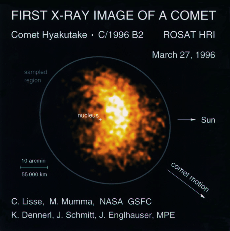First X-Rays from a Comet Discovered
 A team of U.S. and German astrophysicists have made the
first ever detection of
X-rays coming from a comet. Their discovery of a strong radiation signal --
about 100 times brighter than even the most optimistic predictions -- was made
March 27, 1996, during observations of
Comet Hyakutake using Germany's orbiting
ROSAT satellite.
A team of U.S. and German astrophysicists have made the
first ever detection of
X-rays coming from a comet. Their discovery of a strong radiation signal --
about 100 times brighter than even the most optimistic predictions -- was made
March 27, 1996, during observations of
Comet Hyakutake using Germany's orbiting
ROSAT satellite.
"It was a thrilling moment when the X-rays from the comet appeared on our screen at the ROSAT ground station," said Dr. Konrad Dennerl of the Max Planck Institute for Extraterrestrial Physics (MPE) in Garching, Germany. Following the initial detection, the team reported repeated X-ray emissions from the comet over the next 24 hours. The comet was near its closest approach to the Earth at a distance of less than 10 million miles when it was first detected by ROSAT.
The strength of the X-ray emission from Comet Hyakutake took the astronomers by surprise, and they are also puzzled by the rapid changes in their intensity.
"We had no clear expectation that comets shine in X-rays," said Dr. Michael J. Mumma of NASA's Goddard Space Flight Center (GSFC) in Greenbelt, MD, but the opportunity to search for this radiation in a comet coming so close to the earth was too good to miss. Now we have our work cut out for us in explaining these data, but that's the kind of problem you love to have."
The comet was detected repeatedly during March 26-27 as it swept across the sky at a rate equivalent to crossing twice the diameter of the full Moon in an hour. As a result, the comet actually raced through the field of view of ROSAT's X-ray telescope during each 2,000-second exposure. The German scientists were able to correct for the comet's motion during each observation, and produce accurate images with the aid of a computer.
The difficult observations of the swift comet were made possible because of special arrangements made between MPE and the German mission control center in Oberpfaffenhofen, Germany. The comet observations were scheduled to take place exactly when ROSAT would be in real-time contact with the ground station at Weilheim, Germany. Also, the usual two-week period for processing of the ROSAT data was expedited for the comet program, so that the data were transmitted to members of the science team shortly after they were acquired. "It's a great example of international cooperation in science," said the U.S. Project Scientist, Dr. Robert Petre (GSFC). "We're very grateful to our German colleagues for the opportunity to work with them on a historic discovery."
X-rays were never found from a comet before, and scientists had optimistically predicted an intensity that turned out to be about 100 times weaker than the radiation actually detected by ROSAT. Strong changes in the brightness of the X-rays were another surprise. There were pronounced increases and decreases in the X-ray brightness from one ROSAT observation to another, typically over a time difference of a few hours.
Still another puzzle is the nature of the physical process that generates the X-rays, but the ROSAT image may contain clues to this process. In the image, the X-rays from the comet seem to come from a crescent-shaped region on the sunward side of Comet Hyakutake. Unlike the visible light from the comet, the nucleus or solid body is not only not the brightest point in the comet. In fact, the scientists say, the nucleus does not show up in the X-ray image from ROSAT.
Explaining the unexpected bright X-ray emission is the next major task for the science team. One preliminary theory is that X-ray emission from the Sun was absorbed by a cloud of gaseous water molecules surrounding the nucleus of the comet, and then were re-emitted by the molecules in a process physicists call "fluorescence."
According to this idea, the cloud is so thick that its sunward side absorbs nearly all the incoming solar X-rays, that none reach the remainder of the cloud. This could explain why the cometary X-ray emission has the form of a crescent, rather than that of a sphere around the nucleus.
A second possible explanation is that the X-rays are produced from the violent collision between the comet material and the supersonic "wind" of plasma and particles streaming away from the sun.
"We always learn something new when we study an object at different wavelengths," commented Dr. Carey M. Lisse of GSFC, the leader of the X-ray investigation. "Now we have to determine why the comet is so bright in X-rays, and see what we can learn about its structure and composition from these unique images."
The research was conducted by GSFC planetary scientists Lisse and Mumma, along with Drs. Dennerl, Jakob Englhauser, and Jürgen Schmitt of the MPE, and the German and U.S. ROSAT Project Scientists, Professor Joachim Trümper of MPE and Dr. Petre (GSFC), respectively. Comet Hyakutake was discovered on January 30, 1996, and was subsequently approved as a Target of Opportunity for ROSAT, which means that the regular schedule of satellite operations was reorganized to enable the observations of the comet.
![]() Return to the HEASARC Home Page.
Return to the HEASARC Home Page.
![]() Go to the NASA Home page.
Go to the NASA Home page.

